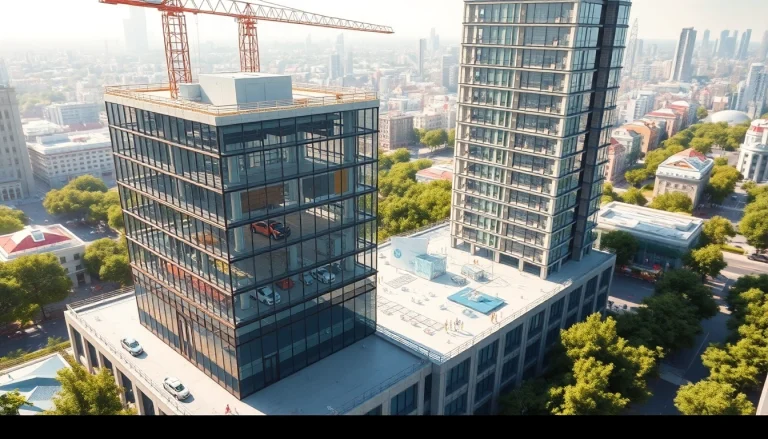
Understanding International Real Estate Development
Defining International Real Estate Development
International real estate development encompasses a wide spectrum of activities related to the creation, management, and investment in property across national borders. This field integrates real estate development processes—from initial planning and financing to construction and marketing. In broad terms, it includes the development of residential, commercial, and mixed-use properties, extending its reach to various global markets and regulatory environments.
The significance of international real estate development cannot be overstated, as it fuels economic growth, provides essential housing solutions, and aligns with strategic urban planning efforts. Understanding the nuances of the international real estate landscape is crucial for stakeholders who are keen on tapping into global opportunities. This detailed exploration will delve into different dimensions of international real estate development, shedding light on its evolution, current implications, and future directions.
Historical Evolution of Real Estate Across Borders
Real estate development has a rich history that has evolved significantly due to globalization, technological advancements, and changing consumer preferences. In the earlier days, real estate was primarily localized, with developments limited by geographical boundaries. However, the late 20th century marked a pivotal shift towards international investment as trade barriers diminished and emerging markets began to open up.
In the wake of globalization, multinational corporations expanded their footprint, often necessitating the development of office spaces, retail centers, and industrial facilities in multiple countries. As a result, international real estate development emerged as a critical avenue for addressing the spatial needs of businesses operating on a global scale while paving the way for urbanization in various regions.
Importance of International Collaboration in Development
Collaborative efforts among countries, developers, and investors are essential in navigating the complexities of international real estate development. Such collaboration encourages the sharing of best practices, technological innovations, and investment strategies. Partnerships between private and public sectors across borders can maximize resources and drive sustainable urban development projects that cater to diverse populations.
Additionally, international collaboration in real estate encourages cultural exchanges and fosters economic integration, allowing countries to leverage each other’s strengths. By working together, nations can address issues such as housing shortages in urban areas, environmental sustainability, and efficient land use, ultimately leading to resilient and prosperous communities.
Current Trends Impacting International Real Estate Development
Sustainable Practices Shaping Global Projects
The real estate industry is experiencing a seismic shift towards sustainability, urging developers to adopt eco-friendly practices in their projects. The principles of sustainability are not merely trends; they have become essential criteria that influence investment decisions and property valuations. Developers are increasingly prioritizing energy-efficient designs, renewable materials, and green certifications in their projects, which reflect a long-term commitment to environmental stewardship.
In many regions, regulatory frameworks are being established to encourage sustainable development practices, requiring developers to integrate environmental considerations into their planning processes. As market demand shifts towards sustainable living, properties that embody these principles are not only more attractive to buyers but also contribute to reduced operational costs over time.
Technological Innovations in Real Estate Development
Technology has become a game-changer in the international real estate development landscape. PropTech—technology-driven solutions for real estate—has introduced innovations that streamline the entire development process. From virtual reality (VR) for immersive property tours to blockchain for secure transactions, these technologies are reshaping how projects are conceived, financed, and marketed.
Moreover, Building Information Modeling (BIM) helps in optimizing construction processes, allowing teams to collaborate in real-time, anticipate issues, and enhance project efficiencies. With the rise of smart cities, integrating technology with urban design is critical in developing infrastructures that are not only modern but also beneficial for citizens’ quality of life.
Market Demands Influencing Development Strategies
Market demands significantly influence international real estate development strategies, as developers must remain agile in response to shifting consumer preferences and economic conditions. There is an observable trend towards urban living, as younger generations prioritize accessibility to amenities, employment, and transportation. Consequently, this has led to a surge in mixed-use developments that blend residential, commercial, and recreational spaces.
Additionally, demographic changes, such as increasing populations and aging societies, compel developers to create adaptable and inclusive environments. This includes the development of affordable housing units, senior living facilities, and co-working spaces that cater to diverse lifestyles and income levels.
Key Players in International Real Estate Development
Roles of Developers and Investors
Within the realm of international real estate development, several key players collaborate to bring projects to fruition. Developers serve as the orchestrators, managing the intricate processes of planning, financing, and executing development projects. Their role involves extensive market research, feasibility studies, and stakeholder engagement to ensure the successful delivery of each project.
Investors provide the necessary capital, playing a crucial role in determining the viability of development projects. Their investment choices are often guided by risk assessments and projected returns on investment. In recent years, the rise of institutional investors has shifted the landscape, as these entities seek to diversify their portfolios by entering international markets.
Understanding Regulatory Frameworks Globally
Navigating the regulatory frameworks governing real estate development can be one of the most challenging aspects of international projects. Each country possesses its own set of rules regarding ownership rights, zoning regulations, environmental compliance, and tax obligations. Knowledge of these regulations is critical for avoiding legal pitfalls, minimizing risks, and optimizing the development timeline.
Developers often engage local legal experts and consultants to ensure adherence to regulations, but keeping abreast of geopolitical changes and economic conditions is also vital. The dynamic nature of international relations can directly impact regulations and the overall investment climate in various countries.
The Impact of Economic Conditions on Development
The broader economic environment significantly affects international real estate development. Economic conditions, such as GDP growth, inflation rates, and employment levels, influence market demand for various property types and the ability to undertake new projects. A robust economy generally correlates with increased consumer confidence and spending, driving demand for commercial and residential properties.
Conversely, economic downturns can lead to price corrections, affecting the profitability of development projects. This creates challenges for developers who must adapt their strategies to mitigate risks during uncertain times. Flexibility and a keen understanding of local market dynamics are crucial for navigating these economic fluctuations successfully.
Challenges in International Real Estate Development
Navigating Legal and Cultural Barriers
Engaging in international real estate development entails confronting numerous legal and cultural barriers that can complicate project execution. Legal differences, such as property rights and contracting practices, vary widely from one jurisdiction to another. Developers must familiarize themselves with local laws to avoid disputes and ensure the smooth progress of their projects.
Moreover, cultural considerations play a pivotal role in shaping development outcomes. Understanding local customs and consumer preferences is essential for designing properties that resonate with the target audience. Engaging local stakeholders and conducting thorough market research can help bridge the gap between different cultural contexts and enhance the acceptance of new developments.
Market Volatility and Risk Management
Market volatility is an inherent challenge in international real estate development, particularly in regions experiencing significant economic transitions. Fluctuations in demand, regulatory changes, and geopolitical risks can present formidable obstacles. To mitigate these risks, developers must adopt robust risk management strategies that incorporate thorough market analysis and scenario planning.
Establishing flexible project schedules and financial structures can help developers respond adroitly to market changes. Moreover, diversifying investments across various geographical areas and property types can provide a safety net against localized economic downturns.
Strategies for Securing Financing in Different Markets
Securing financing for international real estate projects often presents unique challenges due to varying market conditions and investor expectations in different regions. Developers must identify the appropriate funding sources, whether through traditional bank loans, private equity, or joint ventures. Establishing reliable relationships with financial institutions can facilitate access to capital and mitigate financing risks associated with international projects.
Additionally, preparing comprehensive business plans and showcasing strong market research can instill confidence in investors and lenders. Comprehensive assessments of potential returns, risks, and exit strategies play a vital role in securing necessary funds and ensuring project viability.
Future Outlook for International Real Estate Development
Predictions for Market Growth and Innovations
The future of international real estate development appears promising, bolstered by an increasing focus on urbanization and technological advancements. As populations continue to gravitate toward urban centers, the demand for housing and commercial spaces is expected to rise. Developers must stay ahead of the curve by embracing innovative designs and construction techniques that cater to changing demographics and lifestyles.
Moreover, advancements in technology, such as digital twins and IoT, will reshape how developers plan and manage projects, leading to improved efficiencies and enhanced user experiences. Developers who embrace these technologies will likely gain a competitive advantage in the evolving market landscape.
The Role of Urbanization in Future Developments
Urbanization will continue to be a driving force in shaping international real estate development strategies. As cities expand and evolve, the demand for sustainable, inclusive, and resilient urban environments grows. Developers need to be proactive in addressing issues related to infrastructure, transportation, and public services, ensuring their projects align with broader urban development goals.
Furthermore, integrating smart city concepts into new developments will become increasingly vital. Creating interconnected urban spaces that leverage technology to optimize energy use, improve transportation, and enhance living standards will be central to addressing the challenges of urban growth.
Emerging Markets with High Development Potential
As global dynamics shift, new emerging markets are gaining traction among international investors seeking growth opportunities in real estate development. Regions such as Southeast Asia, Latin America, and parts of Africa exhibit significant potential due to rising populations, urbanization trends, and expanding middle classes.
These markets offer developers an opportunity to create diverse and innovative projects that cater to evolving consumer needs. However, successful entry into these markets requires thorough due diligence, local partnerships, and an understanding of the socio-economic landscape. By embracing these emerging markets, developers can position themselves at the forefront of international real estate development.






